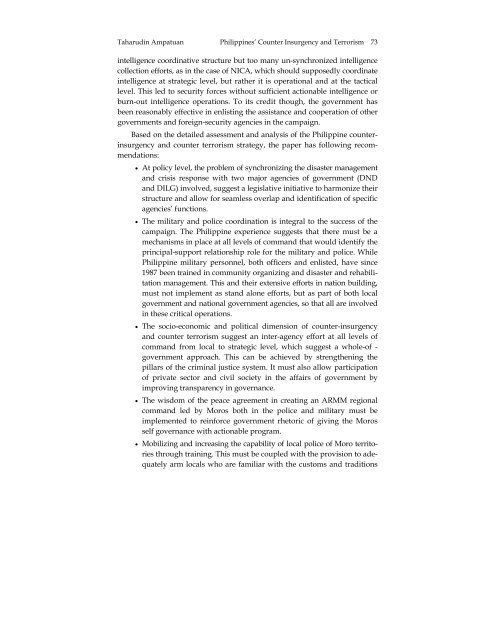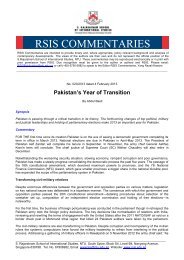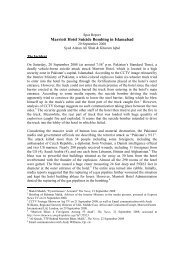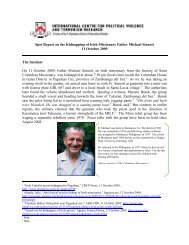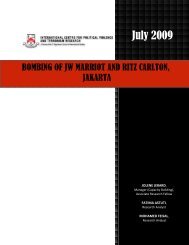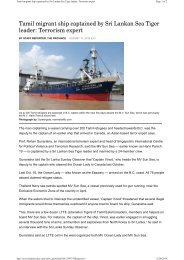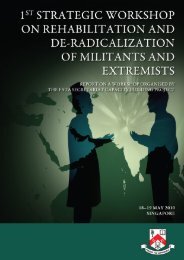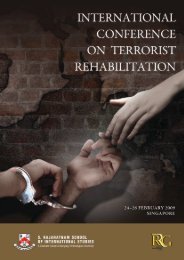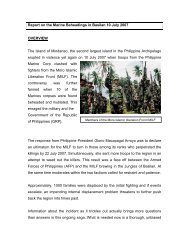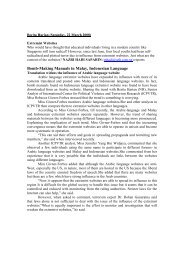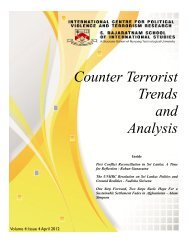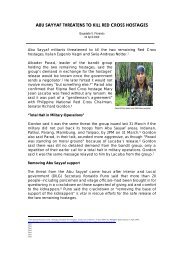Peace and Security Review, Vol.1 No. 2 - International Centre for ...
Peace and Security Review, Vol.1 No. 2 - International Centre for ...
Peace and Security Review, Vol.1 No. 2 - International Centre for ...
You also want an ePaper? Increase the reach of your titles
YUMPU automatically turns print PDFs into web optimized ePapers that Google loves.
Taharudin Ampatuan Philippines’ Counter Insurgency <strong>and</strong> Terrorism 73<br />
intelligence coordinative structure but too many un-synchronized intelligence<br />
collection ef<strong>for</strong>ts, as in the case of NICA, which should supposedly coordinate<br />
intelligence at strategic level, but rather it is operational <strong>and</strong> at the tactical<br />
level. This led to security <strong>for</strong>ces without sufficient actionable intelligence or<br />
burn-out intelligence operations. To its credit though, the government has<br />
been reasonably effective in enlisting the assistance <strong>and</strong> cooperation of other<br />
governments <strong>and</strong> <strong>for</strong>eign-security agencies in the campaign.<br />
Based on the detailed assessment <strong>and</strong> analysis of the Philippine counterinsurgency<br />
<strong>and</strong> counter terrorism strategy, the paper has following recommendations:<br />
• At policy level, the problem of synchronizing the disaster management<br />
<strong>and</strong> crisis response with two major agencies of government (DND<br />
<strong>and</strong> DILG) involved, suggest a legislative initiative to harmonize their<br />
structure <strong>and</strong> allow <strong>for</strong> seamless overlap <strong>and</strong> identification of specific<br />
agencies’ functions.<br />
• The military <strong>and</strong> police coordination is integral to the success of the<br />
campaign. The Philippine experience suggests that there must be a<br />
mechanisms in place at all levels of comm<strong>and</strong> that would identify the<br />
principal-support relationship role <strong>for</strong> the military <strong>and</strong> police. While<br />
Philippine military personnel, both officers <strong>and</strong> enlisted, have since<br />
1987 been trained in community organizing <strong>and</strong> disaster <strong>and</strong> rehabilitation<br />
management. This <strong>and</strong> their extensive ef<strong>for</strong>ts in nation building,<br />
must not implement as st<strong>and</strong> alone ef<strong>for</strong>ts, but as part of both local<br />
government <strong>and</strong> national government agencies, so that all are involved<br />
in these critical operations.<br />
• The socio-economic <strong>and</strong> political dimension of counter-insurgency<br />
<strong>and</strong> counter terrorism suggest an inter-agency ef<strong>for</strong>t at all levels of<br />
comm<strong>and</strong> from local to strategic level, which suggest a whole-of -<br />
government approach. This can be achieved by strengthening the<br />
pillars of the criminal justice system. It must also allow participation<br />
of private sector <strong>and</strong> civil society in the affairs of government by<br />
improving transparency in governance.<br />
• The wisdom of the peace agreement in creating an ARMM regional<br />
comm<strong>and</strong> led by Moros both in the police <strong>and</strong> military must be<br />
implemented to rein<strong>for</strong>ce government rhetoric of giving the Moros<br />
self governance with actionable program.<br />
• Mobilizing <strong>and</strong> increasing the capability of local police of Moro territories<br />
through training. This must be coupled with the provision to adequately<br />
arm locals who are familiar with the customs <strong>and</strong> traditions<br />
<strong>Vol.1</strong>, <strong>No</strong>.2 2008 pp.49-76


